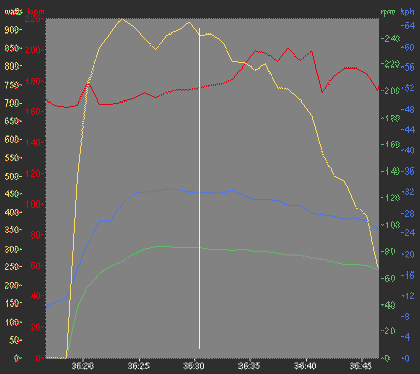Anaerobic Capacity

oxygen debt, anaerobic-ness and pain,
all rolled in to in one!
For the sake of this discussion, we'll simplify things to a basic level. Other factsheets will cover physiology in greater detail but for now we will run with the idea that there are two ways in which we produce power to propel our bike forward. Aerobic power and anaerobic power.
Aerobic basically means "with oxygen" and anaerobic means "without oxygen".
Anaerobic Capacity
Anaerobic power, as we've already established is the
power produced without the requirement for oxygen to be present. Sprinting, at the end of a race, is predominantly an anaerobic activity.
And as you all know power at these intensities can only be sustained for a
short period of time. But why?
The answer lies in the energy systems and pathways used to create the power that propel our bikes. Sprinting and other high energy outputs, attacking, jumping gaps etc, are powered by the ATP-PC energy systems. The ATP system (Adenosine Triphosphate) is sustainable for one to four seconds and the PC system (Phosphate Creatine) will power the anaerobic activity from four seconds until the PC system runs out; which is possibly up to twenty seconds in well trained athletes.
A graphic example of the exhaustion of the ATP-PC energy systems can be seen at the end of a race with a long sprint. When the sprint starts from a long way out the one's who didn't preserve their ATP-PC systems, or never developed them in the first place through proper training, are the ones going backwards.
The ATP Energy Cycle
ATP is stored in our muscles and is, basically, fuel produced from
the food we eat; our muscles can only produce energy by burning this
fuel. When Adenosine Triphosphate is used to produce energy it loses a phosphate
molecule and becomes Adenosine Diphosphate. A bit heavy but the
diagram below should explain it a bit better.

We have enough ATP to last us a few seconds. When it's all gone the muscles start looking for phosphate molecules and it finds them in the Phosphate Creatine system.
The lonely single phosphate molecules in the PC system (the P in the centre of the diagram) are introduced to the ADP (two molecules) system at the bottom and hey-presto we have ATP (three molecules) again at the top ready to produce more energy.
But not for long, the PC system will become exhausted normally quicker than we would like.
Once the PC system is gone, it's gone. The body then looks to the glucose stores to provide power. When glucose is used as fuel, in the absence of oxygen, we get the dreaded lactate. When the lactate builds and becomes debilitating we must cease anaerobic activity and allow our energy stores to refresh.
Depending on the training you've undertaken, ATP-PC refresh could take one to two minutes. The recovery from a full on glycogen-depletion bonk, will take a lot, lot, lot, longer.
The 30 Seconds Energy Flush
To find out for yourself exactly how it feels,
find a small, quiet hill, that you can take a 20 metre run at. Hit it hard from a standing start
in a big gear. Big ring, lower third of block at the back. Sprint as hard as you can and keep going for a full 30 seconds.
Here's a video, taken on the bumpiest uphill climb in Jersey, of how it should look...
And here's the thirty second power profile from the clip above; with the
Strava Segment also!
You'll find a full explanation through following the link at the bottom
of the page.

A simple thirty second test, with power measuring equipment, on the road or on a turbo, will enable you to measure and evaluate your anaerobic capacity.
The test protocol itself is simple but it is probably one of the hardest and most physically demanding tests you will ever undertake.
The Message
A Wingate Test will allow
you to feel the ATP draining from your muscles and feel the PC cycle kick
in. Then, as the energy systems become depleted, you feel the lactate
accumulation begin. The next ten seconds become the longest
ten seconds of your life.
The results of the test allow valuable information to be gained regarding your anaerobic capacity and the physical capabilities of your energy pathways. Devising a training plan with the specific requirements of addressing the limitations of your anaerobic capacity is a fantastic investment in your training time.
Through increasing your anaerobic capacity you can make significant improvements in the efficiency of your aerobic engine thus allowing you to cruise at a faster speed. Then, when you need your anaerobic energy systems, for the big sprint, you'll find you can sprint harder, faster and longer. And that's what wins races.
You can find a training drill
to help you develop your anaerobic capacity right here...








